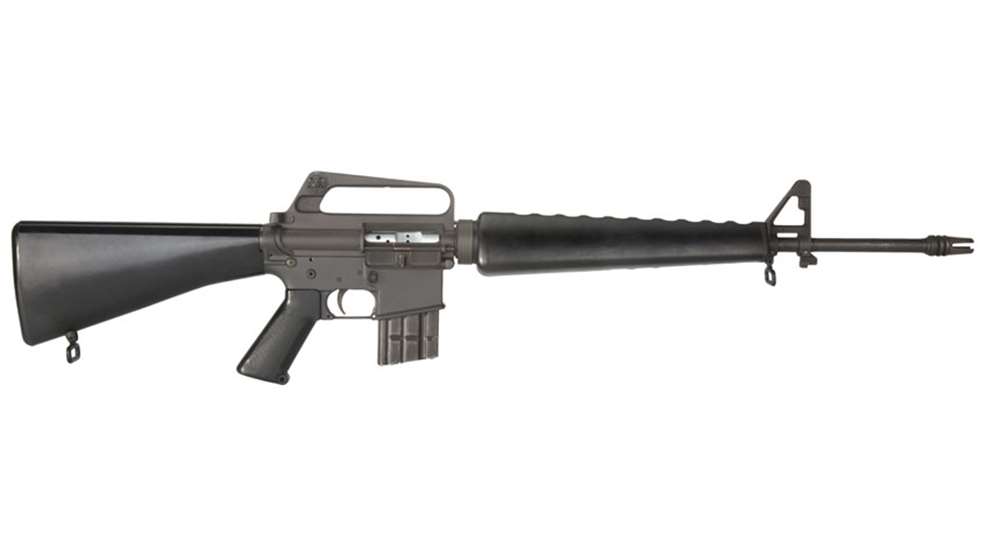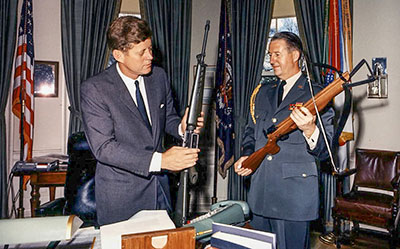
The film “Born on the Fourth of July” (1989) was an interesting take on the life of Ron Covic as played by Tom Cruise. In reality, during the same period depicted in the movie, America’s rifle—the AR-15—was actually born on the Fourth of July, 1960 at the Hagerstown, MD, farm of Fairchild/ArmaLite President Richard Boutelle. It was at this festive picnic that Boutelle invited his good friend, USAF GEN Curtis E. LeMay (soon to be the Air Force Chief of Staff), to try his hand at shooting the company’s newest product: the AR-15 chambered in .223 Rem.

LeMay was smitten, to say the least, and he ordered the USAF to look into acquiring this new rifle to replace its aging stock of World War II-era M2 carbines. What transpired next involved all levels of the Pentagon and took years to sort out, as Secretary of Defense Robert McNamara ordered single-source arms and equipment to arm and equip all branches of the U.S. military. It wasn’t until 1965 that the AR-15 began to face real test trials in the jungles of Vietnam as the selective-fire M16.
A rocky start beset by interservice rivalries and initial problems encountered in the field gave the betting man an edge in laying odds that this “plastic pop-gun” wouldn’t last long in the inventory of our armed forces. Yet, here we are some 55 years later and more than 10 million manufactured, and the M16 (in a multitude of variants) is still serving our men and women in uniform as well as countless foreign armed forces in numbers never dreamed of on that farm in Maryland 60 years ago.
It has now commonly been referenced as America’s Rifle, not only a take on its initials (originally, AR for ArmaLite Rifle), but now AR for America’s Rifle.
Civilian sales of the Colt-manufactured AR-15 were sluggish, to say the least, during the 1960s. The “It’s swell, it’s Mattel” stigma had not completely worn off yet, as the public didn’t accept it as a practical utility rifle at first. Colt did not sell more than 20,000 on the consumer market in a single calendar year until 1980.
The “Assault Weapons Ban” of 1989 and the Crime Bill of 1994 did a lot to spur public interest in a rifle that was on the endangered list, politically. With Colt’s monopoly running out and manufacture of the gun now in public domain, some 32 companies were manufacturing them by early 1990.
The NRA stepped in to ensure that some of the more onerous and meaningless provisions of these gun-ban attempts were quashed in legislative committee and a 10-year “sunset” clause was enacted to evaluate the effect of the legislation on overall crime, which, as predicted, turned out to be non-existent.
In 2003, manufacture of ARs across the board totaled 103,000 units, the first time that more than 100,000 ARs had ever been manufactured in any given year. The 1994 Crime Bill sunset, with the FBI concluding that the bill banning rifles with combinations of pistol grips, flash hiders and bayonet lugs had no discernible effect on crime rates.
Today, more than 230 companies manufacture the AR-15 and its derivatives, making it the single most popular rifle in the country—actually in the history of the country. Conflicts in the Middle East since the early 1990s have led to the rifle being modularized so it can accommodate numerous accessories. It is a staple of the Military Rifle competition at the National Matches every year, which the NRA continues to manage and supervise ever since its founding in 1871.
With more than 10 million ARs in private hands, and having been proven on battlefields around the world, in hunting fields from the Dakotas to wherever prairie dogs roam, as a defensive arm for countless private citizens and on competition ranges far and wide, the AR is truly America’s Rifle.






































